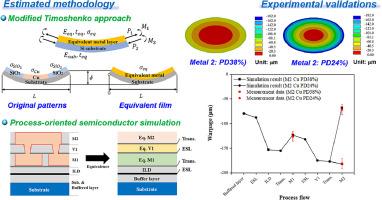先进半导体铜互连工艺的应力诱发翘曲估算
IF 7.1
1区 工程技术
Q1 ENGINEERING, MECHANICAL
International Journal of Mechanical Sciences
Pub Date : 2024-09-19
DOI:10.1016/j.ijmecsci.2024.109744
引用次数: 0
摘要
电子产品的需求和高晶体管密度推动了半导体行业的发展。然而,复杂的制造工艺会产生残余应力,导致晶片翘曲。因此,掌握晶圆翘曲已成为一项重要挑战。本研究提出了一种以工艺为导向的仿真方法,并采用基于仿真的等效材料法,以克服有限元建模的困难和大量的计算时间。针对等效材料残余应力的估算,讨论了三种不同的方法,包括体积百分比法、代表性体积元素法和 Timoshenko 双材料法。此外,每种方法都通过面向过程的模拟和与测量数据的比较进行了验证。Timoshenko 双材料方法能有效预测生产线后端 (BEOL) 互连中的翘曲,并能全面了解 BEOL 不同阶段中发生的翘曲变化。本文章由计算机程序翻译,如有差异,请以英文原文为准。

Stress-induced warpage estimation of advanced semiconductor copper interconnect processes
The growth of the semiconductor industry is driven by the demand for electronic products and high transistor density. However, complex manufacturing processes generate residual stress and result in wafer warpage. Therefore, mastering wafer warpage has become a crucial challenge. This study proposes a process-oriented simulation methodology with simulation-based equivalent material method to overcome the difficulty of finite element modeling and the substantial amount of computation time. Three different methodologies, including volume percentage, representative volume element, and Timoshenko bi-material approach, are discussed due to the estimation of residual stress for equivalent material. In addition, each methodology is validated through process-oriented simulations and comparison with measurement data. The Timoshenko bi-material approach is efficient in predicting warpage in the back end of line (BEOL) interconnects and provides a comprehensive understanding of the warpage variation that occurs during different stages of BEOL.
求助全文
通过发布文献求助,成功后即可免费获取论文全文。
去求助
来源期刊

International Journal of Mechanical Sciences
工程技术-工程:机械
CiteScore
12.80
自引率
17.80%
发文量
769
审稿时长
19 days
期刊介绍:
The International Journal of Mechanical Sciences (IJMS) serves as a global platform for the publication and dissemination of original research that contributes to a deeper scientific understanding of the fundamental disciplines within mechanical, civil, and material engineering.
The primary focus of IJMS is to showcase innovative and ground-breaking work that utilizes analytical and computational modeling techniques, such as Finite Element Method (FEM), Boundary Element Method (BEM), and mesh-free methods, among others. These modeling methods are applied to diverse fields including rigid-body mechanics (e.g., dynamics, vibration, stability), structural mechanics, metal forming, advanced materials (e.g., metals, composites, cellular, smart) behavior and applications, impact mechanics, strain localization, and other nonlinear effects (e.g., large deflections, plasticity, fracture).
Additionally, IJMS covers the realms of fluid mechanics (both external and internal flows), tribology, thermodynamics, and materials processing. These subjects collectively form the core of the journal's content.
In summary, IJMS provides a prestigious platform for researchers to present their original contributions, shedding light on analytical and computational modeling methods in various areas of mechanical engineering, as well as exploring the behavior and application of advanced materials, fluid mechanics, thermodynamics, and materials processing.
 求助内容:
求助内容: 应助结果提醒方式:
应助结果提醒方式:


